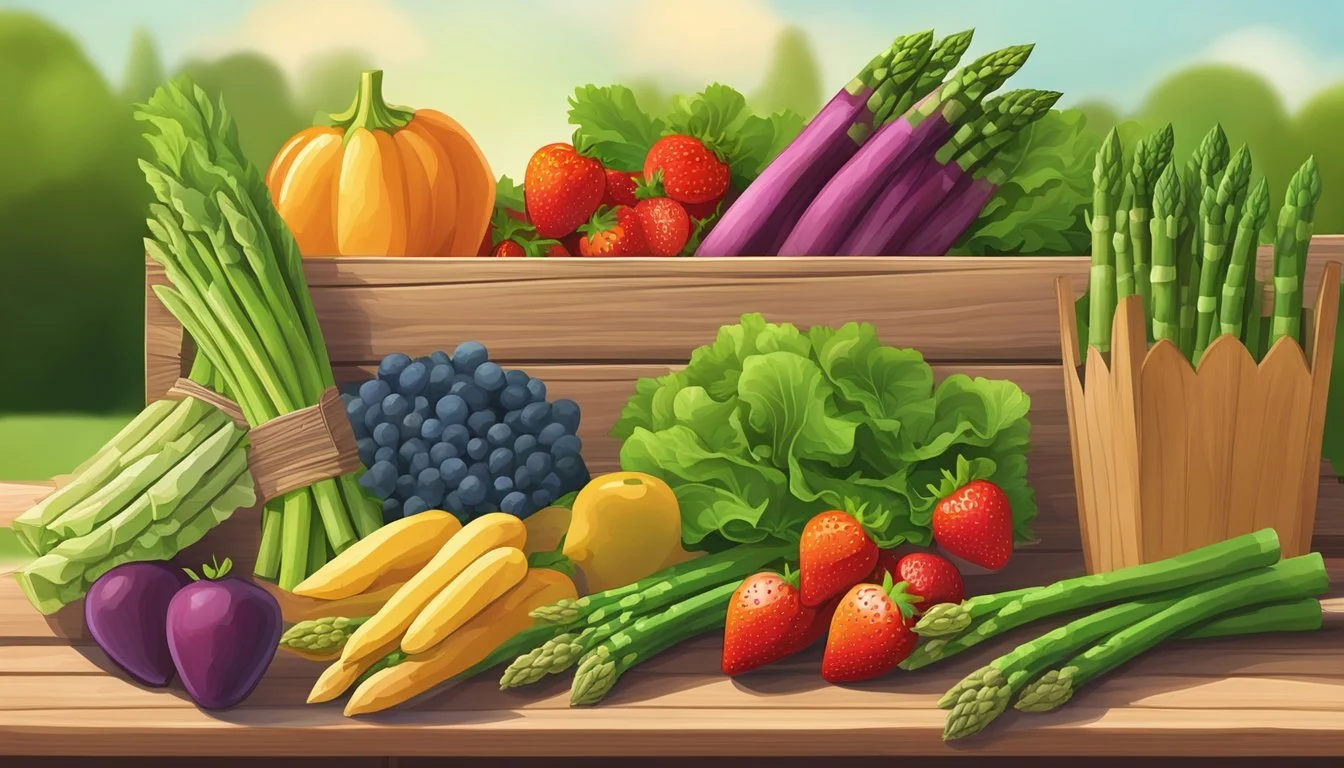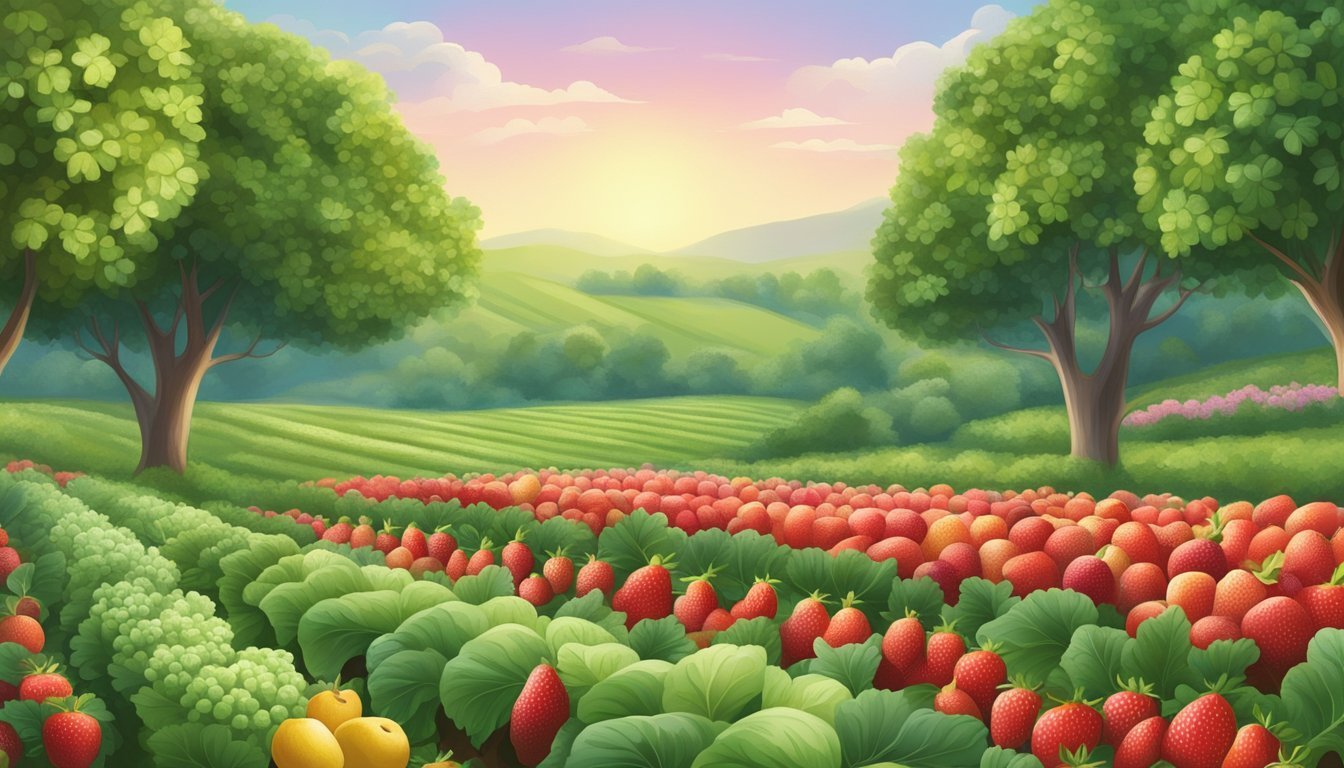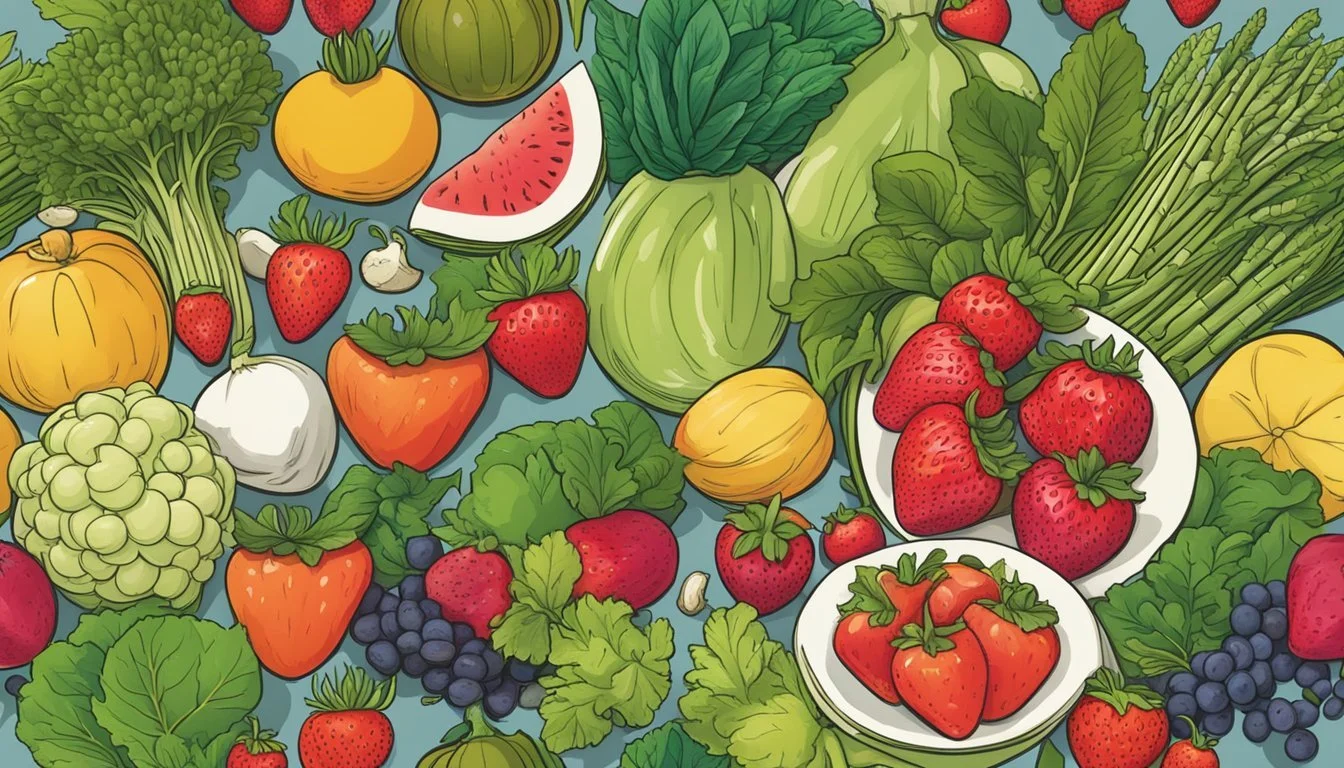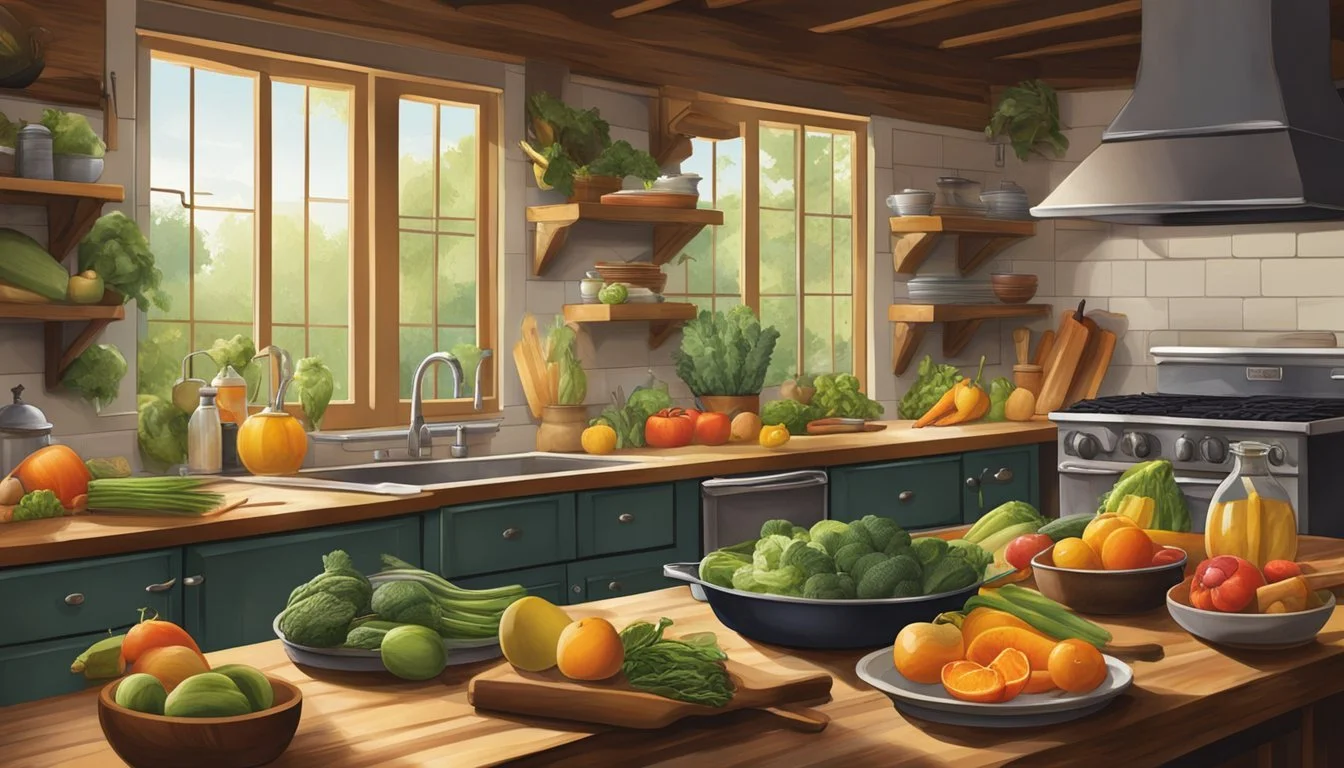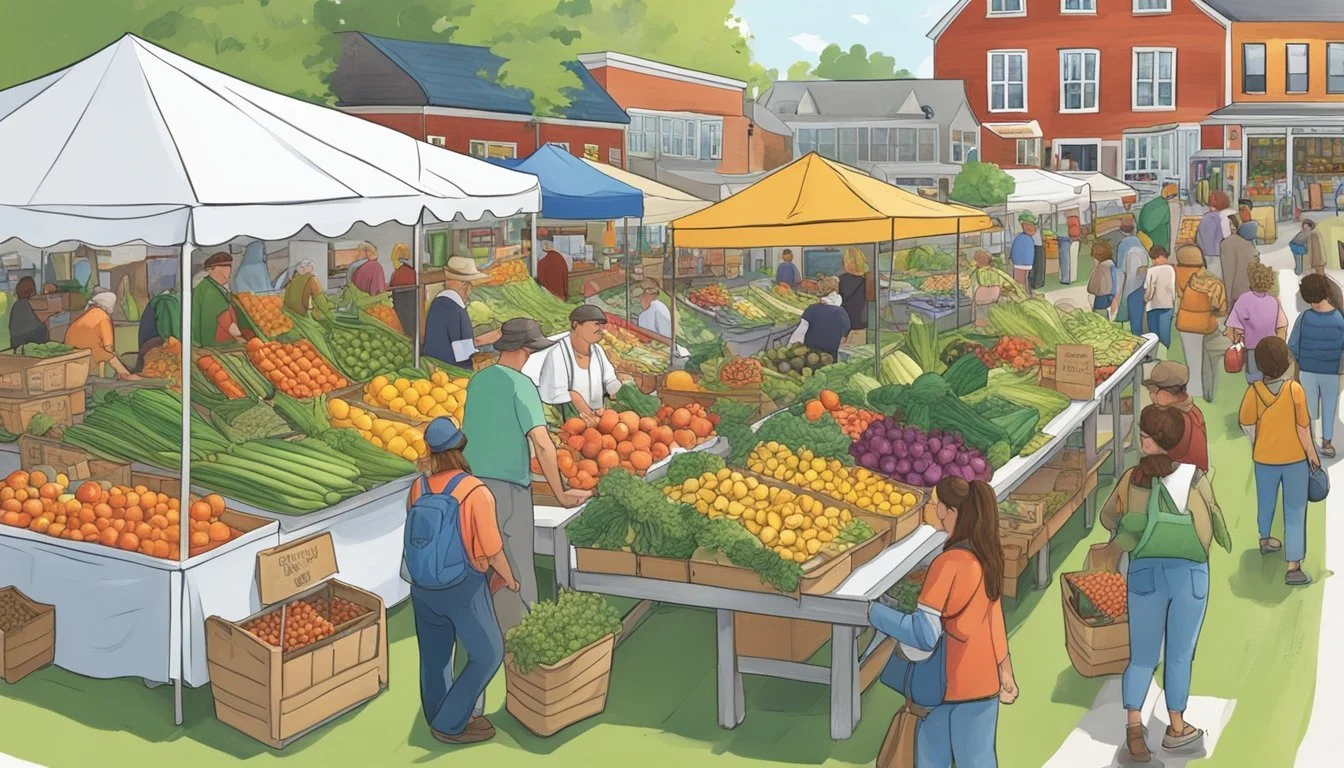Vermont Seasonal Fruit & Vegetables in May
Your Freshness Guide
This Article is Part of our Vermont Seasonal Fruit & Veg Calendar
As spring peaks in Vermont during May, the shift in weather ushers in a fresh cohort of fruits and vegetables, marking the beginning of the local growing season. The melting snow and warming soil allow farmers to harvest a variety of produce that is not only fresher but also packs peak flavor and nutritional value. The increasing daylight and moderate temperatures provide ideal conditions for a range of crops, ensuring that local markets are stocked with the finest selection of produce.
In this period, consumers eagerly await the availability of lush greens and the first burst of vibrant produce after the long winter. May's cooler days support the growth of arugula, lettuce, and green onions, which are ready to be plucked fresh from the fields. The arrival of asparagus (how long does asparagus last?) spears is celebrated as one of the first signs of spring, alongside the tender stalks of rhubarb, which begin to make their appearance. Meanwhile, greenhouses nurture the early stages of what will become summer staples, setting the stage for a fruitful season ahead.
Navigating the seasonal offerings, Vermont boasts an array of farm-to-table options that maintain a local and sustainable food system. The emphasis on seasonal produce not only supports local agriculture but also aligns with consumer interest in foods that are at their peak in terms of both taste and nutrition. This alignment ensures that as the days grow longer, Vermont residents and visitors can look forward to an ever-expanding selection of fresh fruits and vegetables, embodying the essence of the season.
Seasonal Overview
As May arrives, Vermont transitions from the cool, budding days of spring into the cusp of warm summer, bringing a shift in available produce.
Changing Seasons: From Spring to Summer
In Vermont, May is a month of transformation where spring matures into early summer. The temperatures moderately increase, providing the optimal climate for a variety of fruits and vegetables to thrive. This season not only signifies a change in the weather but also cues the growth of fresh, local produce that is valued for its nutrition and flavor.
What’s In Season?
During this time, in season selections abound with spring harvests peaking and early summer produce beginning to make an appearance. Below are some of the fresh fruits and vegetables typically available in May in Vermont:
Fruits:
Strawberries (signaling the onset of berry season)
Rhubarb (a tart, perennial favorite)
Vegetables:
Asparagus (a spring staple)
Radishes (crisp and peppery)
Leeks (mild and versatile)
Spring peas (sweet and tender)
Spinach (What wine goes well with spinach?) (rich in nutrients)
Carrots (crunchy and sweet)
Artichokes (how long do artichokes last?) (a thistle with edible buds)
Farmers and gardeners monitor the weather closely as they prepare for the full arrival of summer, when the assortment of in season produce will expand even more.
Fruits in Season
In Vermont during May, residents and visitors will experience a limited but delightful variety of fruits as the season transitions from spring toward summer. The focus is primarily on the early ripening berries and the tail end of storage apple varieties.
Berry Delights
Strawberries: Starting in late May, Vermont's strawberry season begins to pick up. These sweet, juicy berries are often found at the beginning of their season towards the end of the month. They can be enjoyed fresh, in jams, or in desserts.
Tree-Grown Treasures
While peaches, pears, and blueberries are not yet in season, apples (how long do apples last?) from the previous fall harvest may still be available. Stored properly, certain apple varieties maintain their quality and can be found in markets:
Apples: Older varieties of apples like Ida Red or Fuji, which store well, can be available. They are suitable for eating fresh or for baking.
Vegetables in Season
May in Vermont showcases the emergence of various vegetables, signaling a time of fresh and vibrant produce. These selections are known for their nutritional value and freshness.
Leafy Selections
May sees an abundance of leafy greens flourishing in Vermont. Among them, kale, lettuce, and spinach are prime examples. These leafy greens are not only versatile in recipes but are also packed with essential vitamins and minerals.
Kale: A robust green packed with vitamins A, K, and C.
Lettuce: Offers a variety of types, each with a unique taste and texture.
Spinach: Known for its iron content, it’s a versatile ingredient for both raw and cooked dishes.
Roots and Tubers
Root vegetables like potatoes and parsnips thrive in the spring climate of Vermont. Potatoes and parsnips are root vegetables that can be used in a multitude of recipes, from roasted sides to hearty stews.
Potatoes: A staple with a variety of culinary uses, high in potassium and fiber.
Parsnips: An ancient vegetable with a sweet, earthy flavor when cooked.
Additionally, radishes offer a peppery crunch, perfect for salads and garnishes. They're typically harvested in spring, which includes the month of May.
Radishes: Crisp and spicy, ideal for adding a fresh bite to dishes.
Herb and Other Harvests
Within Vermont's diverse tapestry of produce, May heralds a time of vibrant growth for a range of herbs and other harvests. This period sets the scene for the infusion of fresh, aromatic flavors into local cuisine, as well as the availability of some unique regional specialties.
Flavorful Additions
Herbs: May sees an abundance of fresh herbs in Vermont, which are essential for elevating the flavors in culinary dishes. Gardens and markets offer a variety of herbs including:
Parsley
Cilantro
Dill
Chives
Mint
These herbs are not only used for their flavor but also for their garnishing qualities, adding a fresh touch to spring meals.
Chard: Another leafy green making its presence known is chard. Its tender leaves can be harvested in May, offering a slightly bitter taste and versatility in dishes, from sautéed sides to inclusion in salads.
Unique Regional Varieties
Rhubarb: A perennial favorite in Vermont, rhubarb usually makes its first appearance in May. Recognized for its tartness, it is often used in desserts like pies and crumbles, as well as in savory applications.
Color Varieties: Rhubarb stems can range from green to deep red, with the latter often sought after for its visual appeal.
Asparagus: Celebrated for its delicate flavor and tender texture, asparagus begins to emerge in May. A highlight of the spring harvest, it is used in everything from simple roasts to elegant appetizers.
Harvesting: Asparagus should be harvested when it reaches approximately 6 to 8 inches in height and the spears are firm.
These harvests provide a significant contribution to Vermont's seasonal offerings, integrating well into local cuisine and highlighting the natural cycle of growth and renewal in the region's agriculture.
Gardening in Vermont
In Vermont, gardening in May requires an understanding of the regional weather patterns and a well-planned calendar to optimize plant growth. Gardeners must consider the state's cooler spring temperatures while selecting and planting crops.
Planting Tips
May's unpredictable weather in Vermont necessitates choosing cold-hardy plants and being mindful of the last frost date, which can occur late into the spring. Gardeners should protect sensitive plants, like tomatoes, from potential cold snaps. Lettuce and apple trees are excellent choices for this time of year, as they are cold-hardy and can manage the cooler temperatures that sometimes extend into May.
It is beneficial to enrich garden soil with compost before planting to provide nutrients necessary for the growth of a variety of vegetables and fruits. Since Vermont's weather can shift, gardeners should be prepared to water their gardens more often if May proves drier than usual.
Gardening by the Calendar
May:
Monitor weather forecasts diligently for frost warnings and be prepared to cover vulnerable plants.
Start seeds indoors for warmth-loving plants to transplant after the danger of frost has passed.
June:
Transition to planting warm-season crops, as the risk of frost diminishes and soil temperatures rise.
Provide support structures for climbing plants like beans and peas as they begin to grow.
July:
Establish a consistent watering schedule to combat the higher temperatures and support plant growth.
Begin harvesting early-planted crops such as lettuce and continue to plant successive crops for a prolonged harvest.
August:
Continue to harvest mature fruits and vegetables.
Start planning and planting fall-harvest crops, considering Vermont's shorter growing season.
Nutritional Benefits
In May, Vermont's seasonal fruits and vegetables offer a myriad of nutritional benefits. Fruits such as melons and raspberries are not only at their peak flavor but also supply essential vitamins and antioxidants. Melons, rich in vitamins A and C, support the immune system and eye health. Raspberries contain high levels of fiber and vitamin C, aiding in digestive health and providing anti-inflammatory properties.
Vegetables such as spinach, lettuce, and radishes also abound. Spinach is a nutritional powerhouse, boasting high levels of iron, folate, and vitamins A and K. These nutrients are crucial for blood health, DNA repair, and maintaining healthy skin and bones. Lettuce varieties offer hydration and fiber, which promote satiety and aid in digestion. Radishes, often enjoyed for their crisp texture, are sources of vitamin C and anthocyanins, with potential cardiovascular benefits.
Incorporating these seasonal offerings into recipes enhances not only the nutritional content but also the taste of meals. The fresh, vibrant flavors of May's produce can inspire a range of dishes, from fruit salads to roasted vegetable platters.
In summary, the fruits and vegetables available during Vermont's May season provide essential nutrients that contribute to overall health. They are primed for use in a variety of recipes, promoting a diet rich in natural flavors and wholesome constituents.
Cooking and Recipes
In Vermont, May's bounty offers a plethora of fresh produce ideal for creating vibrant dishes and preserving the season's flavors. This section provides insights into crafting seasonal recipes and employing preservation techniques that best utilize May’s harvest.
Seasonal Recipes
May in Vermont brings a variety of fresh produce that can be used to craft flavorful and nutritious meals. Ingredients such as asparagus, radishes, and ripe strawberries can be highlighted in the following recipes:
Asparagus: Grilled or roasted with a touch of olive oil, salt, and lemon to enhance its natural flavor.
Radishes: Sliced thinly and added to salads for a crisp, peppery note.
Strawberries: Macerated with a sprinkle of sugar and served over shortcake or blended into smoothies.
Preservation Techniques
Preserving May's harvest allows these flavors to be enjoyed throughout the year. Here are some key techniques:
Blanching and Freezing: Asparagus and peas benefit from blanching before freezing, retaining their color and nutrients.
Pickling: Radishes and other root vegetables can be pickled to prolong their shelf life and add a tangy dimension to future meals.
By focusing on these methods, one can extend the life of May's produce while maintaining much of its fresh taste and nutritional value.
Shopping and Availability
In May, Vermont's local produce reaches a point of transition where late spring offerings become available. Shoppers find an increasing variety of fresh fruits and vegetables at farmers markets and grocery stores throughout the state.
Farmers Markets
Farmers markets in Vermont boast an array of freshly harvested produce in May. They typically offer:
Fruits: Strawberries begin to make an appearance towards the end of the month.
Vegetables: Greens such as spinach and kale, radishes, and early lettuces can be commonly found.
These markets provide consumers with the opportunity to buy directly from local farmers, ensuring peak freshness and supporting the local economy.
Grocery Store Selections
Grocery stores in Vermont supplement local produce with items from broader regions to offer a more consistent year-round selection. In May, shoppers can expect:
Fruits: Apples from the previous season's storage, and potentially early strawberries.
Vegetables: A variety of greens, asparagus, and greenhouse-grown herbs and tomatoes.
While the variety of local fruits may be limited, grocery stores make efforts to stock seasonal vegetables that are grown in Vermont greenhouses or in the field when available.
Sustainable Practices
In Vermont during May, sustainable practices emphasize the support for local farming and availability of organic options, which contribute positively to the environment and community health.
Local Farming
Local farms in Vermont engage in sustainable farming techniques to minimize environmental impact and support the local economy. They provide a variety of in-season produce such as spinach, lettuce, and radishes. Farmers' markets and CSA shares, like those offered by Pete’s Greens, are typical outlets where local farming shines in May.
Farmers' Markets: These act as direct channels for consumers to buy fresh and local produce.
CSA Shares: Community Supported Agriculture offers a way for consumers to buy seasonal food directly from their local farmers.
Organic Options
Organic farming is a critical part of sustainable agricultural practices in Vermont. Many farms in the region, following the practices of farms like Pete’s Greens, avoid using synthetic pesticides and fertilizers, instead focusing on maintaining soil health and biodiversity.
Certified Organic: This label guarantees that agricultural practices meet national organic standards.
Non-Certified Organic: Some local farmers follow organic practices but may not be certified due to the cost or size of their operations.
By adhering to these sustainable practices, Vermont's farms not only contribute to healthier ecosystems but also offer consumers high-quality, flavorful produce in May and beyond.




